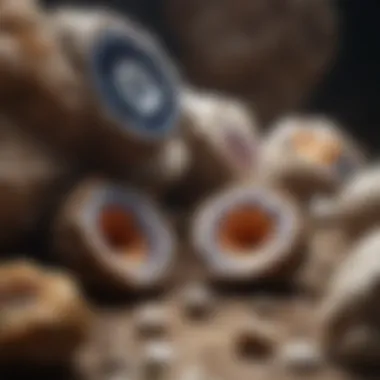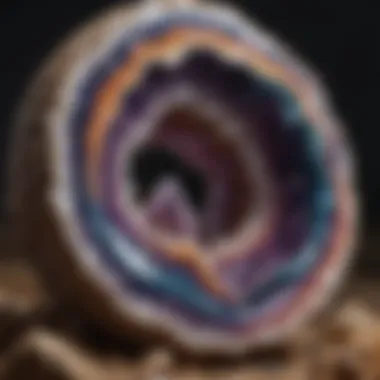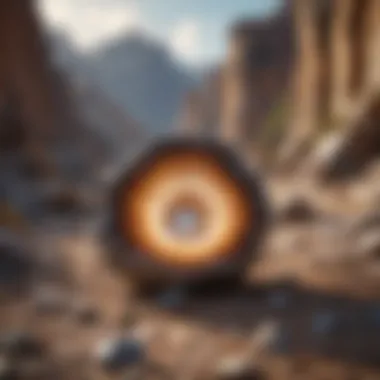Where to Find Geodes: A Comprehensive Guide


Intro
Geodes captivate many people interested in geology, rock collecting, and nature. These hollow rocks with mineral-lined interiors showcase beauty that many find irresistible. Over the years, geodes have gained fame, especially for their stunning quartz and calcite crystals. Enthusiasts often seek them out, eager to add new finds to their collections. In this guide, we will explore how to locate these enigmatic rocks, their geological importance, and methods for successful collection.
Topic Overview
Definition of the collectible
A geode is a spherical or oblong rock that contains a hollow cavity lined with crystals or mineral matter. These formations can range from small pea-sized specimens to larger ones the size of a soccer ball. Geodes typically form in volcanic or sedimentary rocks. They are created when mineral-rich water seeps into a cavity, depositing minerals over time.
Brief history and significance
The fascination for geodes spans various cultures and centuries. Historically, they have been seen as symbols of wisdom and protection. Scientific exploration has also emphasized their geological significance. Understanding how geodes form helps scientists learn about Earth’s processes and mineral deposits. Collecting geodes provides insight into the planet's history, making them valuable for both personal enjoyment and research.
Identification and Classification
Identifying a geode among regular stones can be tricky. Here are some techniques and tips that can assist enthusiasts.
How to categorize items
Geodes come in various types based on their appearance. Common categorizations include:
- Quartz geodes
- Amethyst geodes
- Calcite geodes
- Agate geodes
Recognizing these variations can enhance the collecting experience. Each type has unique characteristics, contributing to its allure.
Tips for identifying key features
When searching for geodes, consider these indicators:
- Shape: Look for rounded or oval-shaped rocks.
- Surface Texture: A rough exterior might indicate the presence of a hollow cavity.
- Weight: Geodes tend to feel heavier than their size suggests due to the minerals inside.
Keep these factors in mind while exploring potential sites. The thrill of discovery can make any hunt worthwhile.
"The adventure of finding a geode is not just about the rock itself, but the journey taken to uncover its hidden beauty."
Tools and Techniques for Collection
While the skills of identifying geodes are crucial, having the right tools can make the process smoother. Essential tools for geode hunting include:
- Sturdy gloves
- A rock hammer
- A chisel
- Safety goggles
Safety should always come first. Make sure to wear protective gear to avoid injuries.
Techniques for successful hunting
When it comes to collecting geodes, methods vary based on location. Here are some effective techniques:
- Visual Inspection: Examine the ground for unusual shapes.
- Digging: Gently dig in areas with loose gravel or sediment.
- Panning: Use a pan to sift through materials in rivers or streambeds.
Practicing these methods increases the likelihood of successful finds, turning each outing into a meaningful experience.
Understanding Geodes
Understanding geodes is essential for anyone interested in rock and fossil collecting. This section lays the foundation for what geodes are and explores their unique characteristics. Knowing the fundamentals of geodes helps collectors identify potential geode locations and enhances their experience when searching. It is not just about collecting; it is about appreciating the geological processes that create these fascinating formations.
Definition of Geodes
Geodes are hollow, spherical geological structures found within sedimentary or volcanic rocks. They typically contain crystals or mineral deposits lining the inner cavity. The outer shell of a geode is often composed of a harder rock, providing protection against weathering. This complex structure is what makes geodes a coveted find for collectors. The beauty of a geode lies in its diverse inner contents, which can include quartz, agate, calcite, and other minerals. This variety makes each geode unique.
Formation Process


The formation of geodes occurs over long geological timescales. Most geodes begin as gas bubbles in volcanic lava or as hollow cavities in sedimentary formations. Over time, mineral-rich water infiltrates these cavities. As the water evaporates, minerals precipitate out, leading to the growth of crystals on the inside surfaces. This process can take thousands to millions of years. The environment in which a geode forms significantly affects its composition, size, and appearance.
Types of Geodes
There are several types of geodes, each distinguished by their internal mineral content and formation process. Common types include:
- Quartz Geodes: Contain quartz crystals, often clear or smoky in color.
- Agate Geodes: Have colorful banded patterns of agate formed by layered deposits.
- Calcite Geodes: Lined with calcite crystals, known for their translucent appearance.
- Amethyst Geodes: Featured predominantly by purple amethyst crystals, highly sought for their beauty.
- Selenite Geodes: Known for their delicate and fibrous crystal structures.
Each type brings its own allure to collectors, making them integral to any geode-hunting expedition.
Geological Context
In the journey to find geodes, understanding the geological context is crucial. Geodes form under specific conditions in certain environments. Becoming acquainted with these settings will improve your chances of finding them. Knowing what to look for in terms of geology is not simply beneficial; it is essentially a prerequisite for serious collectors.
Geodes are predominantly found in volcanic or sedimentary rock formations. These environments offer the necessary properties that support the formation of these hollow cavities. In addition, many geodes are associated with regions that have experienced significant geological events, such as volcanic activity or the deposition of minerals.
Geological Settings Required for Geodes
The foundational characteristics of rocks that host geodes include:
- Volcanic Rock: Certain volcanic landscapes, especially those that have undergone explosive eruptions, often reveal geodes. Here, the cavities in the rock can fill with minerals like quartz or calcite.
- Sedimentary Environments: In sedimentary rocks, especially those formed from silica-rich sediments. Periods of evaporation can lead to the crystallization of geode interiors.
These settings are prevalent in regions like Utah and Arizona where volcanic activity has left behind diverse geological formations. Therefore, anyone serious about geode hunting should focus on these environments and understand the underlying processes.
Identifying Potential Geode Locations
Identifying where to look is half the battle in finding geodes. Potential sites are often located in:
- Former Volcanic Areas: Look for ancient lava flows that have cooled and cracked. These locations are rich in geodic material.
- Riverbeds and Stream Banks: The erosion carried by water often uncovers geodes. Walking along these areas may yield discoveries previously concealed by sediment.
- Construction Sites: New buildings or roads can expose layers of earth that may contain geodes. However, it's vital to respect property rights and gain permission.
In addition to these physical markers, local geological surveys or mining reports can provide insights into areas ripe for exploration. Being informed about local geology enhances the chances of a fruitful geode-collecting expedition.
Finding a geode can be rewarding. However, it is essential to have patience and to approach geode hunting with an understanding of the geological context. The more one knows, the more they find.
Where to Find Geodes
Finding geodes is not just an adventure; it connects individuals with natural history. This section highlights significant locations to find geodes, offering insight into why these areas are optimal for collectors. Knowledge about these geographical hotspots enhances the ease and satisfaction of the geode hunting experience. Additionally, understanding the specific characteristics of each location helps in making informed decisions for productive expeditions.
Popular Locations in North America
Utah
Utah is a prominent destination for geode hunters. The distinct geological formations offer a variety of geodes containing unique crystals. Known for its vast landscape, Utah provides various opportunities for collectors to explore. One key characteristic is the abundance of thundereggs in places like the scenic Frenchman Mountain, which draw many enthusiasts. The unique feature of Utah's geodes is that they often contain beautiful quartz crystals, adding to their visual appeal. However, collectors should consider that some areas may require permits, and proper research is essential before venturing out.
Arizona
Arizona stands out as another leading location for geode collection. The state offers a range of landscapes from deserts to mountains, each hosting its own type of geodes. A notable aspect of Arizona is the Agate House, which showcases numerous agate geodes. These geodes are especially mesmerizing when cut open to reveal their intricate patterns. The arid environment aids in preserving these geological formations, making Arizona a popular choice. However, heat during summer can be a disadvantage, so collectors must plan their visits accordingly.
California
California offers diverse environments that are rich in geodes. The Mojave Desert, in particular, is known for its beautiful geodes containing calcite and quartz. One significant advantage of collecting geodes in California is the variety of geological formations available. Each site may reveal different types of geodes, enhancing the collector's portfolio. Nevertheless, the area can be challenging due to uneven terrain and sometimes harsh weather, which may pose risks to inexperienced collectors.
International Sites for Geode Hunting
Brazil
Brazil is renowned for its geologically rich areas, particularly in the state of Minas Gerais. This location is famous for its stunning amethyst geodes, which are highly sought after across the globe. The unique feature of Brazil's geodes is their large size and intricate interior designs. Collecting geodes in Brazil can be quite rewarding, though potential legal restrictions and export regulations should be thoroughly understood before any collection efforts.
Mexico
Mexico has a reputation for offering unique geode-hunting experiences, especially regions like Chihuahua. The beauty and vibrancy of Mexican geodes attract collectors worldwide. These geodes often reveal stunning calcite or quartz crystals inside. Additionally, collectors appreciate the relatively easy access to many sites. However, potential legal and logistical challenges exist, necessitating a careful approach to collection to avoid conflicts with local regulations.


Argentina
Argentina is home to a number of untapped geode locations, particularly in Catamarca. This area is known for its breathtaking and colorful geodes, making it an attractive spot for collectors who enjoy less commercialized hunting experiences. The unique aspect of Argentina’s geodes is the variety of minerals found within them, often leading to unexpected discoveries. However, this region is still developing in terms of accessibility and support for geode hunters, which may present challenges in planning trips.
Each location offers distinct advantages and challenges. A well-researched approach is vital for successful geode hunting.
Geode Hunting Techniques
Geode hunting can be an exhilarating pursuit, combining the thrill of exploration with the promise of discovering nature's hidden treasures. This section highlights essential techniques that any aspiring geode hunter should master to increase their chances of success. Understanding these techniques not only enhances the discovery process but also ensures that collectors engage with the environment in a safe and responsible manner.
Tools Required for Extraction
When venturing out to find geodes, a set of basic tools is crucial. These items aid in safely extracting geodes from the earth without causing damage to both the specimens and the surrounding ecosystem.
- Rock Hammer: A well-balanced rock hammer is an essential tool for breaking open geodes. Opt for one with a heavy head and a comfortable grip. This allows for controlled striking, which is necessary for minimizing fragmentation during extraction.
- Chisel: A sturdy chisel complements the rock hammer. It can assist in prying geodes from their rocky encasements and provide leverage when necessary.
- Safety Goggles: Protecting your eyes is paramount. Flying rock shards can pose a significant risk during geode extraction.
- Gloves: Thick gloves will protect hands from sharp rocks and occasional rough edges on geodes.
- Field Guide: A geology field guide specific to your hunting area can greatly enhance your understanding of the local geology, helping you identify promising sites more effectively.
Safe Digging Practices
Safety should always be a priority while hunting geodes. Engaging in responsible practices not only protects you but also preserves the geodes and their habitats. Here are key considerations for safe digging:
- Choose the Right Location: Avoid areas that are prone to landslides or are unstable. Check if there are any signs of recent erosion or loose soil. Picking a safe site reduces the risks associated with digging and helps maintain the integrity of the surrounding area.
- Work in Pairs: It's advisable to always have a partner while hunting. They can assist in case of an emergency and can offer help if an accident occurs.
- Avoid Overexertion: Digging can be labor-intensive. Take breaks regularly to prevent injury or fatigue. Overexertion can lead to accidents, especially when using heavy tools.
- Dispose of Waste Properly: Always clean up after yourself. Leaving behind any trash or tools can harm the environment and disrupt local ecosystems.
Best Weather Conditions for Finding Geodes
The effectiveness of your geode hunting expedition can be significantly influenced by weather conditions. Here are some considerations to keep in mind regarding the best times to search for geodes:
- Dry Weather: Clear skies and dry ground generally make for easier digging conditions. Wet or muddy ground can obscure geode locations and hinder your ability to extract them.
- Temperature: Moderate temperatures, ideally between 60°F and 75°F, are comfortable for extended outings. Hot or extremely cold weather can make hunting arduous and may necessitate frequent breaks.
- Seasonality: Late spring and early fall are often ideal times for geode hunting. After seasonal rains, the soil can become soft, uncovering hidden geodes and making them easier to find. During these times, access roads are typically more navigable, and the surrounding scenery can enhance the outdoor experience.
Always remember to check local regulations and consider natural conditions before heading out. Respect for nature and legality should guide every geode hunting adventure.
Adopting the right techniques, tools, practices, and understanding environmental conditions can significantly enhance your geode hunting experience. Collecting these geological wonders becomes not only an enjoyable hobby but also an opportunity to deepen appreciation for Earth's natural artistry.
Legal Considerations in Geode Collecting
Engaging in geode collecting can be a thrilling pursuit, yet it is essential to consider the legal framework surrounding this activity. Understanding the legalities helps to protect both the collector and the environment. Collecting geodes involves navigating through various regulations concerning land access, ownership, and conservation. Being informed about these considerations ensures that collectors engage responsibly and ethically.
Understanding Land Ownership
Land ownership greatly influences where geodes can be collected. Several factors are to be noted regarding land types. These include private, state, and federal lands. Collectors must verify the ownership of the land before attempting to collect materials.
- Private Land: Accessing private land requires the owner's permission. Trespassing without consent constitutes a legal violation.
- State and Federal Land: Many geode-rich locations fall under state or federal jurisdiction. Collectors should seek information specific to these areas, as regulations can differ significantly.
- Bureau of Land Management (BLM): For lands managed by the BLM, there may be rules governing the quantity of material that can be collected and the methods of collection permitted.
It's crucial for collectors to be aware that ignorance of land ownership laws is not a valid defense in court. Due diligence is necessary to prevent legal disputes.
Permits and Regulations
Permits play an important role in geode collecting practices. Not every location allows recreational collection. Collectors should familiarize themselves with the necessary permits to ensure compliance with local laws.
- Gathering Limits: Many jurisdictions impose limits on the quantity of geodes that can be gathered. This prevents over-collection and helps to preserve geological sites.
- Permits: In certain areas, collectors are required to obtain a permit for collecting geodes. These permits might come with specific stipulations regarding collection methods and areas.
- Protected Areas: Collecting in national parks or nature reserves is often strictly forbidden to protect local ecosystems. Compliance with these restrictions is critical.
Collecting without proper knowledge of the legalities can lead to hefty fines or even criminal charges.
Understanding these regulations and obtaining the necessary permits fosters respect for natural resources. Collectors benefit by enhancing their experience while ensuring sustainable practices in the field.
Post-Discovery: Preparing Your Geodes
Once you have successfully unearthed geodes, the next phase involves a critical step: preparing your geodes. This process is important since it dictates how these geological treasures will be maintained and showcased. Proper preparation not only enhances their aesthetic appeal but also increases their longevity. Additionally, knowing how to carefully clean and preserve geodes can significantly impact their value, especially for collectors and enthusiasts.
Cleaning Geodes
Cleaning geodes is essential for revealing their inner beauty. Often, geodes emerge from the ground coated in dirt and debris. This outer layer may obscure the stunning crystals or formations within. To clean your geodes effectively, follow these steps:


- Initial Inspection: Examine your geode for cracks or weak points. If there are signs of fragility, take extra care during the cleaning process.
- Dry Brushing: Use a soft brush to gently remove loose dirt. A toothbrush or a soft paintbrush works well for this task.
- Water and Soaking: For stubborn dirt, soak the geode in a bucket of water for a few hours. After soaking, return with the brush to clean away residue. Avoid harsh chemicals, as these can damage the stone.
- Rinsing: Rinse the geode under running water to remove any remaining dirt particles.
- Drying: Pat the geode dry with a clean cloth and let it air dry completely before further processing.
Proper cleaning not only uncovers stunning appearances but also helps to maintain the integrity of the geodes.
Preserving and Displaying Geodes
After cleaning, preserving and displaying geodes is the next logical step. Preservation ensures that your specimens remain in excellent condition, while display techniques showcase their natural beauty.
- Storage: Store your geodes in a cool, dry place away from direct sunlight. Extreme temperature fluctuations can damage them.
- Display Cases: Using display cases can protect geodes from dust and physical damage. Clear acrylic or glass cases are popular choices. They provide visibility while preserving the stones.
- Minimal Handling: Limit handling of the geodes to avoid potential scratching or chipping. When displaying them, consider using soft materials to cushion any points of contact.
- Regular Inspections: Check your geodes periodically for signs of damage or wear. This practice can help you catch any issues early, ensuring prolonged preservation.
- Photography: Documenting your geodes with clear photographs can help preserve memories and assist in any future sales or trades.
Caring for geodes post-discovery can enhance their beauty and value. Taking the time to clean and properly preserve these geological wonders enriches both the personal enjoyment and potential display or sale.
Geodes in Popular Culture
Geodes have captured the fascination of many throughout history, not just for their geological properties, but also for their representation in various aspects of culture. This section delves into how geodes find their place in jewelry, art, and their broader scientific significance that extends beyond their natural beauty.
Geodes in Jewelry and Art
The aesthetic appeal of geodes has made them a popular choice in jewelry making and artistic expressions. Their striking appearance, showcasing intricate crystalline structures, offers a unique blend of beauty and geological history. Jewelry designers often incorporate cut geodes into pendants, earrings, and bracelets, attracting those who appreciate natural elements in fashion.
Artisans use both whole geodes and slices, allowing the raw, unpolished sections to highlight their natural beauty while polished pieces offer a more refined look. The use of geodes in art is not limited to jewelry; they appear in home decor items, sculptures, and as decorative pieces in galleries.
- Popular Uses in Jewelry:
- Pendants and Necklaces: Often worn as statement pieces.
- Earrings: Beautiful slices can dangle or sit as studs.
- Bracelets: Can feature geodes as charms or focal points.
These creations not only serve aesthetic purposes but also create discussions about the origins of the materials used, often connecting the wearer to nature.
Scientific Significance of Geodes
Beyond their beauty and cultural significance, geodes hold a place of importance in scientific circles. They provide valuable insights into geological processes and mineral formation. As such, collectors often engage with geodes not just for their visual appeal but for what they can reveal about Earth’s history.
In geology, studying geodes can help scientists understand:
- Mineral Growth: The conditions under which minerals crystallize within the geodes.
- Paleoclimatology: Insights into historical climate conditions based on mineral composition.
- Volcanic Activity: The relationship between geodes and areas of volcanic activity, often indicating where gases and minerals have circulated.
"Geodes act as natural time capsules, preserving tiny bits of Earth’s history in their crystalline interiors."
Collectively, the cultural and scientific significance of geodes enriches the narrative around these geological wonders, extending their relevance well beyond mere collection.
Final Thoughts on Geode Collecting
The world of geode collecting is not only about the tangible stones but also about the experiences that come along with this hobby. For many enthusiasts, the thrill lies in discovery and the connection to nature. Collecting geodes opens doors to geological education, as it necessitates an understanding of how these unique formations develop. Recognizing the factors that contribute to geode presence can enhance a collector’s ability to spot promising locations and identify when they might be lucky.
Moreover, this activity promotes patience and persistence, vital qualities that can translate into other life aspects. To many, finding a geode is akin to unearthing a treasure. Beyond mere aesthetics, each geode tells a story about the Earth's geological history, making each find significant.
The Joy of Collecting Geodes
Collecting geodes brings immense satisfaction. The joy emerges when one unearths a rock that may seem ordinary from the outside, but reveals stunning crystals and formations once opened. This process demonstrates how appearances can be deceiving. It teaches that beauty often lies beneath the surface. The sense of achievement upon unveiling a geode can lead to dopamine releases, enhancing overall well-being.
Socially, the hobby can foster connections with like-minded individuals. Many collectors join clubs or groups where sharing stories and experiences become a common theme. Participating in group hunts can add a layer of enjoyment and camaraderie, which enhances the entire experience.
Continuing Education and Resources
Books
Books dedicated to geodes and mineral collecting serve as valuable resources. They offer insights into various geode types, identification techniques, and collecting strategies. A well-researched book can enhance one's knowledge, providing a comprehensive background on geology, mineralogy, and proper collection practices. Some of the recognized texts might include detailed diagrams and firsthand accounts from experienced collectors, deepening understanding.
While many books can be beneficial, some may lack updates on new findings or methods, which could render them less useful. Always look for recently published works or those that reference current studies to ensure the information is relevant.
Online Communities
Online communities such as forums on Reddit or specific collector groups on Facebook create platforms for sharing knowledge and tips. They give real-time feedback and discussions about locations, successful digs, or new geode findings. This immediacy creates a dynamic resource for ongoing education.
The key feature of these communities is the access to diverse experiences from collectors around the world. Members share photographs, discuss methods, and even organize group expeditions, which enhances learning. However, caution is warranted in filtering information, as not all suggestions may be accurate or safe. Being discerning in relying on reputable sources within these platforms is essential.
Engaging with both books and online communities helps cultivate a deeper appreciation for geodes and enhances one's collecting journey.



